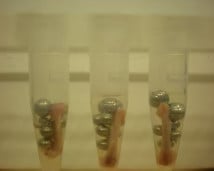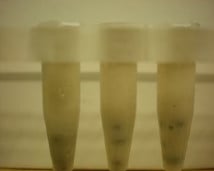Bullet Blender Beads FAQs
Reference Manual (with helpful suggestions and pictures)
Bead Lysis Kits
What are Bead Lysis Kits?
Next Advance Bead Lysis Kits are microcentrifuge tubes pre-filled with bead combinations optimized to homogenize your specific tissue sample. We also make custom kits for 1.5 mL, 2 mL, 5 mL and 50 mL tubes; contact us at [email protected] to learn more.
What are the advantages of Bead Lysis Kits over bulk beads?
The beads are pre-dispensed in known volumes, which reduces inter-sample variability. Experimental setup is also faster: Just add your sample and buffer, and you’re ready to homogenize. The kits also contain a mixture of different beads optimized to provide better results.
What’s the difference between the GATOR kits and the RINO kits?
GATOR kits contain snap- cap, 1.5 mL tubes while RINO® kits contain screw cap, 1.5 mL tubes. Both types contain the same beads, so a GATOR kit and a RINO kit will work for the same sample types and buffer volumes. The RINO tubes offer superior leak resistance, especially with slippery solvents like Trizol. GATOR kits offer the convenience of snap caps.
Can I use my desired sample buffer in a Bead Lysis Kit?
Yes. The kits are compatible with almost all biological buffers. Choose the kit which is appropriate for the volume of sample buffer you wish to use. Pink and Green kits are appropriate for volumes up to 300 μL; Red, Navy and Yellow kits can be used for volumes between 300 and 600 μL.
What’s the advantage of RNase-free Bead Lysis Kits?
Less handling means less risk of RNase contamination. The beads in our RNase-free Bead Lysis Kits are protected until the tube is opened, so the risk of accidental introduction of RNase is greatly reduced. The faster setup also gives your RNA less time to degrade.
Which Bead Lysis Kit should I choose?
The best choice of kit will depend on your sample type and size, and your desired buffer volume. Use the selection guide to identify the kit that is most suitable for your experiments.
Do you offer custom kits?
Yes, we do! If you have a specific bead mixture that you prefer, we can create kits made to your exact specifications at a very reasonable price. Custom kits can be made up in 1.5 mL GATOR tubes, RINO tubes, 5 mL GATOR tubes, or other tube types that might be required by your bead mill homogenizer. Send your kit specifications to [email protected], and we’ll be happy to get you a quote.
Bulk Beads
Can I wash and reuse the beads?
Yes, you can! However, due to the relatively low cost, most Bullet Blender® users choose to simply dispose of the beads after use. Washing (and subsequent rinsing) is a laborious process and if done improperly can lead to cross contamination of your samples.
How do I wash the beads?
Washing in standard laboratory detergent (like Alconox®), followed by rinsing with distilled or deionized water is sufficient. Washing in a sonicating water bath can increase the penetrating ability of the detergent water and multiple rinses are recommended to ensure that all detergent is removed before drying. Acid washing of the beads is not recommended.
Will the beads stick together when I wash them?
After washing, the beads may stick together upon drying. Gently shake the container with the dried beads until they flow freely.
How many times can I reuse the beads?
You may wash and reuse the beads many times. How many uses you can get out of a batch of beads will depend on sample hardness and the speed at which you run the Bullet Blender. Typically, you can reuse the beads about ten times. Stop reusing the beads when cracks appear or there is noticeable wear, including discoloration.
Are the beads RNase free?
Not unless specified. All of our RNase free beads have a part number that ends in “–RNA” and bear a yellow or gold sticker indicating they are certified. If you would like a Certificate of Analysis, these are available upon request — please have your lot number available.
Can I use bulk beads for RNA extraction and analysis?
There are differing observations regarding this. Some insist that using a stabilization reagent during homogenization is sufficient to protect your RNA from degradation. Others report a shift in the 18S and 28S peak when bulk beads are used. Next Advance has observed researcher data with low RIN values when non-certified, bulk beads were used to homogenize samples. For this reason, we recommend that certified RNase free materials be used when the homogenization goal is to extract RNA.
I bought bulk materials. Can I make my beads RNase free?
You can treat non-RNase free beads with a reagent like RNAZap® or RNaseAWAY®, followed by rinsing with nuclease free/DEPC treated water. Allow the beads to air dry in an oven or at ambient temperature. Testing should be performed to determine the degree (or lack thereof) of nuclease activity after treatment. Alternatively, baking the beads at high temperature (450°F / 232°C) for two hours or more has been shown to inactivate RNases.
How do I sterilize the beads?
They can be autoclaved on dry cycle to sterilize them. They may stick, so shake the container with the dried beads until they flow freely. Alternatively, they may be gamma irradiated. Any manipulations of the beads after sterilizing must use aseptic techniques in order to preserve the beads’ sterility.
Which beads are good for homogenizing which samples?
The two basic rules are: (1) a combination of large and small bead sizes works best in most situations, and (2) use denser beads for tougher samples. We have protocols with suggested beads for many samples. If you are unsure, please contact us and we’ll be happy to help.
How do I separate beads from the homogenized sample?
There are several methods to achieve this:
- Use a pipette tip of sufficiently small size to allow whole homogenate to enter but excludes the beads. The tip will filter the beads. Most 300uL tips are of sufficient size to exclude beads with a 0.5mm diameter and up.
- Spin your tubes in a centrifuge for a few minutes. The beads will pool at the bottom of the tube along with the insoluble material. Remove the supernatant with a pipette and dispense in a fresh tube.
Are your beads compatible with my buffer?
In general, the beads are very stable and non-reactive with most common laboratory reagents. There are several known reactions to be aware of:
- Stainless Steel and TRIzol®: If stainless steel beads sit in Trizol for a long time, the buffer will turn black. This reaction is not reported to have any negative effects on the quality or purity of RNA. The dark color in the RNA eluate may interfere with absorbance readings. Working quickly or removing beads after homogenization will minimize this reaction.
- Stainless Steel and 6N HCl: If stainless steel beads sit in 6N HCl overnight the solution becomes blue. This may affect absorbance readings in certain assays and probably should be avoided if possible.



